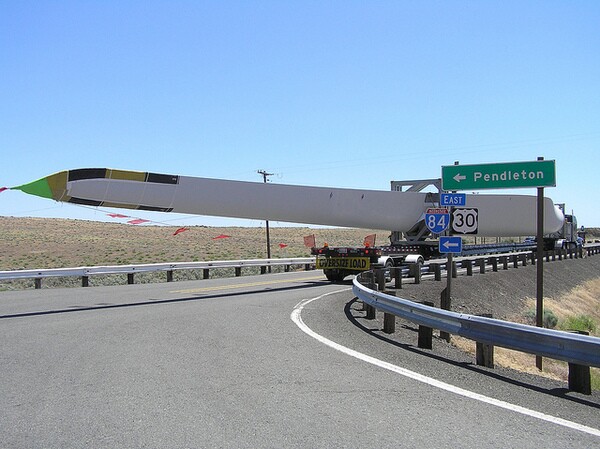SoCal Edison Adds 845 Megawatts of Wind From Oregon

A single turbine blade en route to Shepherds Flat | Photo: Oregon DOT/Flickr/Creative Commons License
The Shepherds Flat Wind Farm, a massive installation of 338 wind turbines along the south shore of the Columbia River in Eastern Oregon, is now online and supplying up to 845 megawatts of power to Southern California Edison. Built by wind, solar, and geothermal energy developer Caithness Energy, Shepherds Flat is either the second- or third-largest onshore wind facility in the world, after the 1.06 gigawatt Jaisalmer Wind Park in India and -- depending on how you define a single installation -- Kern County's Alta Wind Energy Center, whose five units total 1.02 gigawatts.
Related

Explained: Understanding Wind Power
The project attracted corporate investment from Google, Sumitomo, and General Electric, the last of whom supplied the 2.5 megawatt turbines. After gaining approval for the project in 2008, Caithness began construction the next year and received a $1.3 billion loan guarantee from the U.S. Department of Energy in 2010. Caithness and SCE have signed a 20-year power purchase agreement under which the Southern California utility will buy all energy the plant provides.
The wind project attracted scrutiny in 2010 for offering residents of the nearby Town of Ione $5,000 each for signing what Caithness called a "noise easement" -- in other words, effectively paying Ionians to agree not to complain about noise from the turbines.
Shepherds Flat is opening as discussion mounts of the federal wind energy Production Tax Credit, set to expire in December. The law provides wind turbine owners with a tax credit for every kilowatt hour their qualifying turbines generate. The expiration of the tax credit has wind companies nervous, but it's unlikely the coming Lame Duck session of Congress will renew the credit despite some Republican support from the conservative-yet-windy Plains states.
ReWire is dedicated to covering renewable energy in California. Keep in touch by liking us on Facebook, and help shape our editorial direction by taking this quick survey here.


